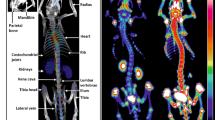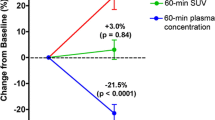Abstract
Previously, we identified a parathyroid hormone-related high-turnover bone disease after gastrectomy in mini pigs. Dynamic [18F]fluoride ion positron emission tomography (PET) revealed that bone metabolism was significantly increased, but that bone blood flow derived from permeability-surface area product (PS product)-corrected K 1 values was not. Since bone blood flow and metabolism are coupled in normal bone tissues, we hypothesised that the capillary permeability and/or surface area might be altered in high-turnover bone disease. The "true" bone blood flow (f H2O) was measured in vertebral bodies by dynamic [15O]H2O PET, followed by a 120-min dynamic [18F]fluoride ion PET study, 6 months after total gastrectomy (n=5) and compared with results in sham-operated animals (n=5). Estimates for bone blood flow based on PS-corrected K 1 values (f) and the net uptake of fluoride in bone tissue (K i), representing the bone metabolic activity, were calculated using standard compartmental modelling and non-linear fitting. Gastrectomy was followed by a significant elevation of K i and k 3 (P<0.05), which was mainly caused by an increase of the fraction of bound tracer in tissue (P<0.01). In contrast, f H2O, f, the single-pass extraction fraction of [18F]fluoride (E) and the volume of distribution (DV) of [18F]fluoride were not significantly different between groups. In both groups, a coupling of the mean f H2O and K i values was found, but the intercept with the y-axis was higher in high-turnover bone disease. It is concluded that in high-turnover bone disease following gastrectomy, the PS product for [18F]fluoride remains unchanged. Therefore, even in high-turnover bone diseases, [18F]fluoride ion PET can provide reliable blood flow estimates (f), as long as a proper PS product correction is applied. The increased bone metabolism in high-turnover bone disease after gastrectomy is mainly related to an up-regulation of the amount of ionic exchange of [18F]fluoride with the bone matrix, while tracer delivery remains unchanged.
Similar content being viewed by others
Author information
Authors and Affiliations
Corresponding author
Additional information
Received 24 November 2001 and in revised form 9 February 2002
Electronic Publication
Rights and permissions
About this article
Cite this article
Piert, M., Machulla, HJ., Jahn, M. et al. Coupling of porcine bone blood flow and metabolism in high-turnover bone disease measured by [15O]H2O and [18F]fluoride ion positron emission tomography. Eur J Nucl Med 29, 907–914 (2002). https://doi.org/10.1007/s00259-002-0797-2
Published:
Issue Date:
DOI: https://doi.org/10.1007/s00259-002-0797-2




